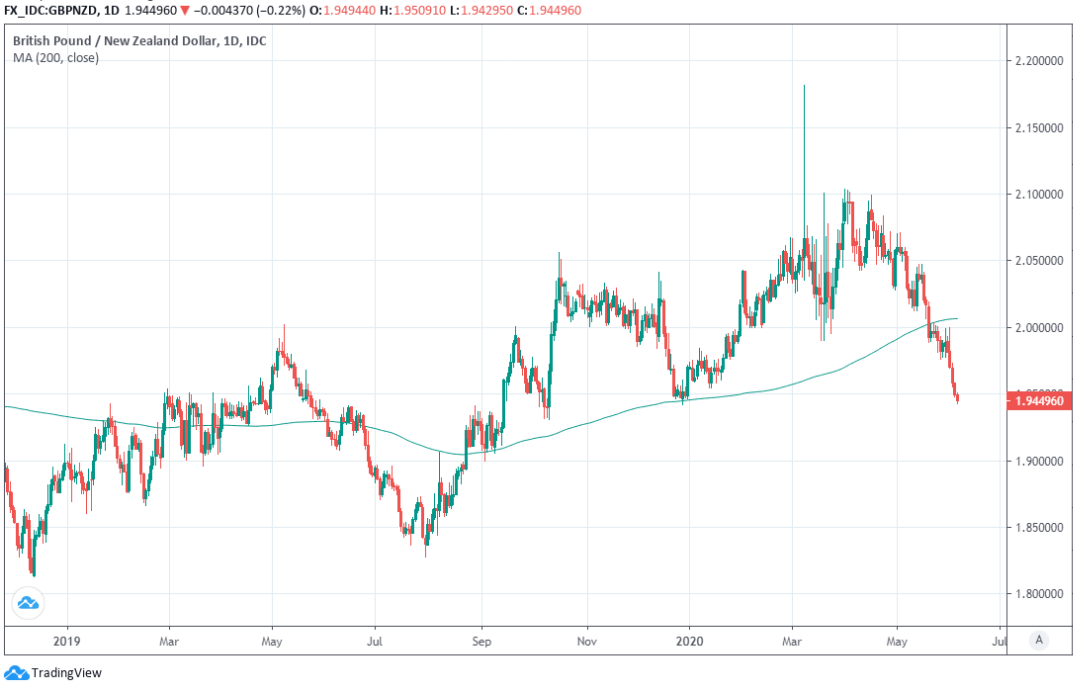Pound-to-New Zealand Dollar Rate Has Further to Fall after Kiwi Erases Coronavirus Loss
- Written by: James Skinner
-
- GBP/NZD on route to bottom of range but has further to fall.
- Draws short-sellers while slipping in 1.9137-to-1.9682 range.
- As NZDUSD erases coronavirus loss while GBP/USD lags.
- Robust risk appetite drives GBP/NZD lower as Brexit returns.

Image © Adobe Stock
- GBP/NZD spot rate at time of writing: 1.9446
- Bank transfer rates (indicative guide): 1.8764-1.8901
- FX specialist rates (indicative guide): 1.1.9153-1.9270
- More on acquiring specialist exchange rates here
The Pound-to-New Zealand Dollar exchange rate was en route to the bottom of its new, lower trading range Friday as the Kiwi continued to erase its coronavirus-related losses in an increasingly confident rally.
Pound Sterling was charging higher against most majors ahead of the weekend but couldn't keep up with either of the antipodeans as investors continued to look past the coronavirus collapse that's set to be borne out in economic data in the months ahead, to position for the beginning of a new business cycle.
That would always favour hard commodities and the riskier but higher-yielding commodity currencies such as the Kiwi over the Dollar, Euro and Sterling.
"This has been a huge week for the reflation trade as investors refuse to hang around for a U shape recovery and are putting money to work straight away," says Chris Turner, head of markets and regional head of research at ING. "A return of investors into [emerging markets] had been one of our key tenets for our bearish 2H20 view on the dollar – this story now seems to be unfolding. This environment will favour pro-cyclical currencies and favour equity over bond markets (UST 10 yields to 1.00%), suggesting Asian FX (ex JPY) may be due a catch-up if US-China tension can stay contained (as it has this week). This is a bearish environment for the USD and the JPY."
Above: Pound-to-New Zealand Dollar rate at daily intervals with 200-day moving-average.
The mistmatch in fortune between the Kiwi and Sterling has driven the Pound-to-New Zealand Dollar rate down by -7.7% since it topped out on April 16, although there's further downside to play out before Sterling reaches the bottom of the 1.9137-to-1.9682 trading range that could dominate price action in the short-term. Pound Sterling Live reported on April 21, when the exchange rate was trading at 2.0662, that exactly this fall could be in pipeline although the outlook for the exchange rate has since evolved.
The fall from 2.0662 to 1.9447 by Friday is testament to the strength of the Kiwi Dollar in the last two months because Sterling has so-far avoided the many and various bearish scenarios that could have befallen it and which may yet burden the currency to at least some extent.
New Zealand had one of the less stretched public purses even before its short-lived affair with the coronavirus, but more so now it's squared away the disease in such good time while others have lagged.
"The NZ economy may be better placed than many but the RBNZ is determined to keep the NZD and NZ rates down. This should cap the currency," says Mike Jones, a senior economist at ASB Bank. "Over the medium-term, the balance of risks probably does favour a higher NZD. The NZ economy is emerging from lockdown in better shape than most, and the outlook for the Terms of Trade – a key fundamental driver of the NZD – is relatively favourable. Our short-term valuation model estimates a “fair-value” range of 0.6100-0.6500, and the trade-weighted NZD is around 8.5% “cheap” relative to our preferred estimate of the currency’s long-run equilibrium."
Above: NZD/USD rate at daily intervals with S&P 500 (orange line) and Fibonacci retracements of 2020 fall.
NZD/USD has been moving in lockstep with the S&P 500 stock index that has also all-but erased the coronavirus from history and given the former's yield and solvency appeal to investors, relative to other major currencies, local analysts are tipping it to remain on the front foot for a while yet. Any further meaningful upside seen in the stock markets during the months ahead would be an upside risk for the NZD/USD rate and a downside risk for Sterling.
New Zealand Dollar gains would be limited in the absence of further increases for stock markets although if NZD/USD followed the S&P 500 back to its February highs then it might be found trading at 0.67. This would produce a Pound-to-New Zealand Dollar rate of between 1.8917 and 1.9137, depending on whether GBP/USD is roadblocked by the 200-day moving average of 1.2675 that it was testing Friday or if it advances further to the 78.6% Fibonacci retracement of the March 2020 fall at 1.2822.
This leaves a lot to be determined by price action in GBP/USD and developments on the ground in the UK over the coming weeks, where Brexit will again be in focus for the Pound as another negotiating deadline draws near.
Above: GBP/USD rate at daily intervals with Fibonacci retracements of 2020 fall.
Negotiators will update the market on trade talks this Friday and if they confirm a continued deadlock then the Pound's northward advance against the U.S. Dollar and other large major currencies could be cut short, placing the Pound-to-New Zealand Dollar rate at risk of further declines.
If Brexit or Bank of England related headwinds were to knock the GBP/USD rate back to 1.24 over the the coming weeks while the NZD/USD rate remains between 0.65 and 0.67, then the Pound-to-New Zealand Dollar rate would break down further into another new, lower trading range. That range would see the exchange rate trading between 1.8507 and 1.9076. It would take an NZD/USD fall back to 0.6375 in order to avert such a decline from Friday's levels.
The above rates would only available at interbank level however, with those quoted to retail and SME customers likely much lower. Some High Street banks were already quoting between 1.8764 and 1.8901 Friday. Specialist firms can help squash the spread between interbank and retail rates.
"Exposure to GBPNZD downside looks like a reasonable position to us, given lingering Brexit risks. This trade also eliminates the USD from the equation," says Stephen Gallo, European head of FX strategy at BMO Capital Markets. "Given the relative underperformance of the NZD (YtD) we judge that there is room for the NZD to close some of that gap with the AUD, so we would look to fade AUDNZD at its current levels. To an extent, this gap is also reflected in the relative performance of local equity markets. Both in USD and local currency terms, New Zealand's equity markets have outperformed their Australian peers YtD, though the NZD is some 3.0% lower vs the AUD."
Above: Pound-to-New Zealand Dollar rate at weekly intervals with 200-week moving-average.

